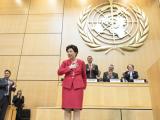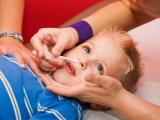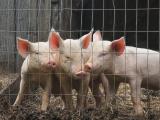Dec 22, 2009
Most parents able to get vaccine for their kids
A new poll by the Harvard School of Public Health found that three quarters of parents who sought H1N1 vaccine for their children got it, according to a Harvard press release. The poll, conducted Dec 16 and 17, showed that 6 in 10 parents have gotten or expect to get their children vaccinated. The share of respondents concerned that they or a family member would get the flu was 40%, down from a high of 52% in September. Fifty-five percent of adults said they didn't intend to get the vaccine.
http://www.hsph.harvard.edu/news/press-releases/2009-releases/poll-parents-tried-to-get-h1n1-vaccine-children.html
Dec 22 Harvard news release
WHO: Deaths don't tell whole story of severity
The World Health Organization (WHO) today addressed the difficulty of assessing the severity of the H1N1 pandemic by comparing H1N1 fatality counts with seasonal flu counts. In a briefing note, the agency said that such comparisons can be misleading because death tolls from seasonal flu are estimates, whereas death numbers for the pandemic usually represent confirmed fatal cases. Such comparisons can also mislead because H1N1 has a greater impact on young people than seasonal flu does.
http://www.who.int/csr/disease/swineflu/notes/briefing_20091222/en/index.html
Dec 22 WHO briefing note
Potential pandemic legacy: Easier future flu seasons
The vast, rapid spread of the H1N1 flu virus could produce unexpected benefits if it displaces current seasonal flu strains, the Canadian Press reported. If the novel H1N1, an influenza A strain, replaced either or both of the current seasonal A strains, H3N2 and an older H1N1, that could lead to lesser mortality, less resistance to antiviral drugs, fewer nursing-home outbreaks, and vaccines with fewer components.
http://www.google.com/hostednews/canadianpress/article/ALeqM5gZMcuOPsQb-L-xZQIp3j0__PwNSQ
Dec 21 Canadian Press story
Study probes low H1N1 mortality in Japan
Despite widespread transmission of H1N1 flu, Japan had only 85 confirmed deaths as of Dec 1, according to researchers writing in PLoS Currents. They report that most cases and hospitalizations have occurred in children aged 5 to 14 years, who are very susceptible to infection but have a very low case-fatality rate. The fatality rate is higher in small children and older adults. Aggressive school closures may have reduced transmission to the latter two age-groups, the authors suggest.
http://knol.google.com/k/taro-kamigaki/epidemiological-characteristics-and-low/38epug6fmizmk/1?collectionId=28qm4w0q65e4w.1&position=1#
PLoS Currents report
WHO clears Novartis vaccines for developing world
The WHO has prequalified all three H1N1 vaccines made by Novartis to be supplied to United Nations agencies for use in the developing world, the company announced yesterday. The vaccines are Celtura and Focetria, both of which contain the MF59 adjuvant, and a nonadjuvanted vaccine based on the Fluvirin seasonal vaccine. The WHO previously prequalified an adjuvanted H1N1 vaccine made by GlaxoSmithKline.
http://www.novartis.com/newsroom/media-releases/en/2009/1365351.shtml
Dec 21 Novartis press release
South Korea mulls more aid for North Korea
In the wake of recent shipments of antiviral medication to North Korea, the government of South Korea is considering sending more assistance, Agence France-Presse (AFP) reported yesterday. A South Korean official said aid may be channeled through agencies such as the United Nation's Children's Fund, Yonhap news agency reported. On Dec 18, South Korea shipped 500,000 antiviral treatment courses to North Korea, the first direct aid in about 2 years.
http://www.mysinchew.com/node/33008?tid=37
Dec 21 AFP story


















